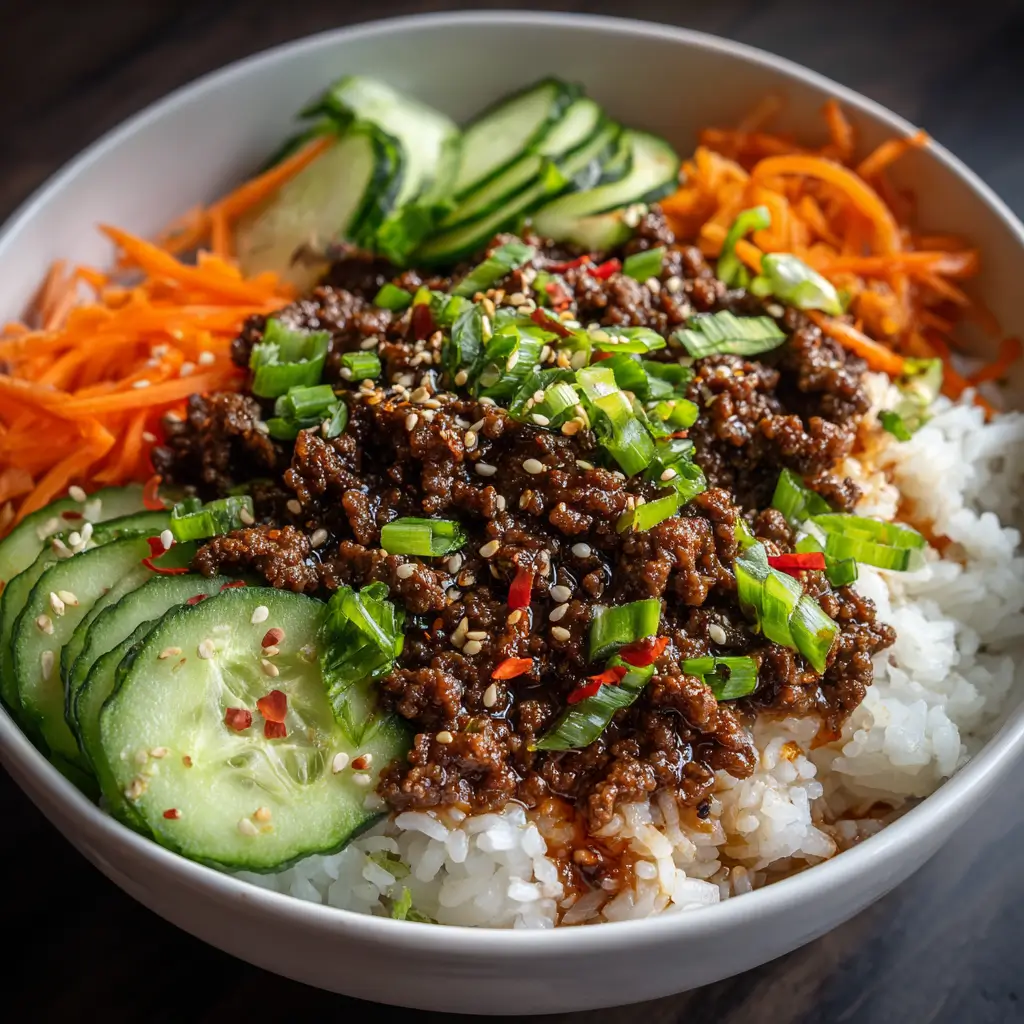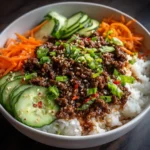Introduction
Korean Beef Bowls are a delightful fusion of savory, sweet, and umami-packed flavors wrapped into a convenient and satisfying meal. Originating from the rich culinary traditions of Korea but adapted for modern, fast-paced lifestyles, these bowls bring the essence of Korean barbecue straight to your table—without the grill. Tender slices of beef marinated in a luscious sauce made with soy sauce, sesame oil, garlic, and ginger are served over steamed rice and topped with crisp vegetables and a sprinkle of sesame seeds. Whether you’re new to Korean cuisine or a seasoned enthusiast, this dish offers an accessible gateway to bold, complex flavors that delight the palate with every bite.
The History
Korean Beef Bowls draw inspiration from traditional Korean dishes such as Bulgogi (fire meat) and Bibimbap (mixed rice). Bulgogi, which dates back to the Goguryeo era (37 BCE–668 CE), was originally prepared by royal cooks who grilled thin slices of marinated beef over open flames. Over centuries, it evolved into a household favorite, especially during the Joseon Dynasty, where marinades became more refined with ingredients like soy sauce, pear juice, and sesame oil. The concept of serving marinated beef over rice likely emerged from Bibimbap, a mixed rice dish that combines various vegetables, egg, and meat in a bowl. As Korean cuisine spread globally in the 20th century, chefs and home cooks began simplifying these recipes for quicker preparation, leading to the creation of modern Korean Beef Bowls—perfect for weeknight dinners, meal prepping, and lunchboxes. Today, they represent a harmonious blend of tradition and convenience, beloved across continents.
Ingredients Breakdown
The magic of Korean Beef Bowls lies in its balance of ingredients, each contributing depth, texture, and flavor:
- Beef: Typically ribeye, sirloin, or flank steak—thinly sliced against the grain for tenderness.
- Soy Sauce: Provides saltiness and umami; use low-sodium if preferred.
- Brown Sugar: Adds sweetness and helps caramelize the beef while cooking.
- Sesame Oil: Imparts a nutty aroma essential to Korean flavor profiles.
- Garlic and Ginger: Freshly minced for pungency and warmth.
- Rice Vinegar or Mirin: Offers a touch of acidity or mild sweetness to balance the sauce.
- Sriracha or Gochujang: For heat; adjust according to spice tolerance.
- Pear or Apple Puree: A traditional tenderizer and natural sweetener often used in authentic bulgogi marinades.
- Green Onions and Sesame Seeds: For garnish, adding freshness and crunch.
- Cooked Rice: White, brown, or even cauliflower rice serves as the base.
- Vegetable Toppings: Carrots, cucumbers, spinach, mushrooms, bean sprouts, or kimchi add color and nutrition.
- Fried or Soft-Boiled Egg: Often added for richness and protein.
Step-by-Step Recipe
- Prepare the Marinade: In a large bowl, whisk together 1/4 cup soy sauce, 3 tablespoons brown sugar, 2 tablespoons sesame oil, 3 minced garlic cloves, 1 tablespoon grated ginger, 1 tablespoon rice vinegar, 1 teaspoon sriracha (optional), and 2 tablespoons pureed Asian pear or apple. Mix until the sugar dissolves completely.
- Slice the Beef: Cut 1 pound of beef (ribeye or sirloin) into thin strips, about 1/4 inch thick, slicing against the grain. This ensures tenderness after cooking.
- Marinate: Add the beef to the marinade and toss to coat evenly. Cover and refrigerate for at least 30 minutes, or ideally 2–4 hours for deeper flavor infusion.
- Cook the Rice: While the beef marinates, prepare 2–3 cups of cooked rice (white or brown) according to package instructions. Keep warm.
- Sauté the Beef: Heat 1 tablespoon of neutral oil (like vegetable or canola) in a large skillet or wok over medium-high heat. Add the marinated beef (reserve the leftover marinade) and cook for 3–5 minutes, stirring frequently, until browned and nearly cooked through.
- Simmer the Sauce: Pour the reserved marinade into the skillet and bring to a simmer. Cook for 2–3 minutes until slightly thickened and glossy. The beef should be fully cooked and coated in a sticky, flavorful glaze.
- Prepare Toppings: While the beef finishes, slice green onions, shred carrots, blanch spinach, or prepare any additional vegetables you’d like to include.
- Assemble the Bowls: Divide the hot rice among serving bowls. Top with the sautéed Korean beef, then arrange colorful vegetables on the side. Sprinkle with toasted sesame seeds and chopped green onions. Add a fried or soft-boiled egg if desired.
- Serve Immediately: Enjoy while hot, mixing everything together just before eating to distribute the flavors evenly.
Tips
- Freeze the Beef Slightly: Place the beef in the freezer for 20–30 minutes before slicing—it firms up and makes cutting paper-thin strips much easier.
- Don’t Overcrowd the Pan: Cook the beef in batches if necessary to ensure proper browning instead of steaming.
- Use Toasted Sesame Oil: Always opt for toasted sesame oil for maximum flavor; regular sesame oil lacks the same depth.
- Balance Sweetness: If the sauce becomes too sweet, add a splash of rice vinegar or a squeeze of lime to cut through the richness.
- Double the Batch: This recipe reheats beautifully—make extra for easy leftovers throughout the week.
- Low-Sodium Option: Substitute tamari or coconut aminos for soy sauce to reduce sodium content without sacrificing taste.
- Add Umami Boosters: A dash of fish sauce or a teaspoon of miso paste can deepen the savory notes subtly.
Variations and Customizations
Korean Beef Bowls are incredibly versatile and can be tailored to suit various dietary preferences and flavor cravings:
- Protein Swaps: Replace beef with thinly sliced chicken, pork, tofu, tempeh, or even shrimp for alternative versions.
- Vegetarian/Vegan: Use portobello mushrooms or seitan and substitute honey with maple syrup or agave to keep it plant-based.
- Spicy Version: Increase gochujang or sriracha in the marinade, or top with spicy kimchi and chili flakes.
- Grain-Free: Serve over cauliflower rice, zucchini noodles, or a bed of mixed greens for a lighter, keto-friendly option.
- Noodle Bowl Style: Swap rice for soba, udon, or rice noodles to create a hearty noodle bowl variation.
- Breakfast Bowl: Top with a runny fried egg, avocado slices, and pickled red onions for a brunch twist.
- Gourmet Touch: Garnish with microgreens, nori strips, pickled daikon, or truffle oil for an elevated presentation.
- Meal Prep Friendly: Store components separately in containers—beef, rice, veggies—and assemble when ready to eat.
Health Considerations and Nutritional Value
A typical serving of Korean Beef Bowls (with 4 oz beef, 1/2 cup rice, and vegetables) contains approximately:
- Calories: 450–550 kcal
- Protein: 25–30g (excellent source for muscle repair and satiety)
- Carbohydrates: 40–50g (primarily from rice and natural sugars in the marinade)
- Fat: 18–22g (mostly healthy fats from sesame oil and beef)
- Sodium: 800–1200mg (can be reduced using low-sodium soy sauce and limiting added salt)
Health Benefits:
- Rich in iron and B vitamins from lean beef, supporting energy metabolism and red blood cell production.
- Sesame oil contains antioxidants and anti-inflammatory compounds like sesamol.
- Ginger and garlic offer immune-boosting and digestive benefits.
- Vegetable toppings increase fiber, vitamins A, C, and K, and phytonutrients.
Dietary Notes:
- Gluten-Free: Ensure tamari or gluten-free soy sauce is used.
- Diabetic-Friendly: Reduce sugar in the marinade using a sugar substitute like erythritol, and pair with cauliflower rice.
- Heart-Healthy: Choose lean cuts of beef, limit added sugar, and use heart-healthy oils in moderation.
Ingredients
- 1 lb (450g) ribeye or sirloin steak, thinly sliced
- 1/4 cup low-sodium soy sauce (or tamari for gluten-free)
- 3 tbsp brown sugar (or coconut sugar/maple syrup)
- 2 tbsp toasted sesame oil
- 3 cloves garlic, minced
- 1 tbsp fresh ginger, grated
- 1 tbsp rice vinegar
- 1 tsp sriracha (optional, for heat)
- 2 tbsp pureed Asian pear or apple (or pineapple juice as tenderizer)
- 1 tbsp vegetable oil (for cooking)
- 2–3 cups cooked white or brown rice
- 1/2 cup shredded carrots
- 1/2 cup sliced cucumber
- 1 cup fresh spinach or blanched bean sprouts
- 3 green onions, sliced
- 1 tbsp toasted sesame seeds
- 4 eggs (optional, fried or soft-boiled)
- Kimchi, for serving (optional)
Directions
- In a mixing bowl, combine soy sauce, brown sugar, sesame oil, garlic, ginger, rice vinegar, sriracha, and pear puree. Whisk until smooth and sugar dissolves.
- Add sliced beef to the marinade, ensuring each piece is well-coated. Cover and refrigerate for 30 minutes to 4 hours.
- Cook rice according to instructions and set aside.
- Heat vegetable oil in a large skillet or wok over high heat. Remove beef from marinade (reserve liquid) and cook in batches for 2–3 minutes per batch until browned.
- Pour reserved marinade into the skillet and bring to a boil. Simmer for 2–3 minutes until sauce thickens into a glossy glaze.
- Return beef to the pan and stir to coat. Remove from heat.
- Divide rice among four bowls. Top with Korean beef, then arrange carrots, cucumber, spinach, and other vegetables around the bowl.
- Add a fried egg if desired. Garnish with green onions and sesame seeds. Serve immediately with kimchi on the side.
FAQ
Can I make Korean Beef Bowls ahead of time?
Yes! Marinate the beef up to 24 hours in advance and store cooked components separately for up to 4 days. Reheat gently on the stove or microwave.
What cut of beef is best?
Ribeye, sirloin, or flank steak work well. Ribeye is most tender and flavorful, while flank steak offers a leaner option.
Is this recipe gluten-free?
Yes, if you use tamari or a certified gluten-free soy sauce.
How can I make it less sweet?
Reduce the brown sugar to 1–2 tablespoons or replace with a non-caloric sweetener.
Can I slow cook the beef?
Absolutely! After marinating, cook on low for 4–6 hours in a slow cooker, then thicken the sauce on the stove.
Can I freeze Korean beef?
Yes, the cooked beef freezes well for up to 3 months. Thaw overnight and reheat with a splash of water to restore moisture.
What can I use instead of pear?
Pineapple juice, mango puree, or kiwi juice act as natural meat tenderizers due to their enzymes.
Summary
Korean Beef Bowls are a vibrant, flavorful, and nutritious meal that brings the bold tastes of Korea into your kitchen with ease. Packed with marinated beef, aromatic spices, fresh vegetables, and fluffy rice, they’re perfect for busy nights, meal prep, or impressing guests.










